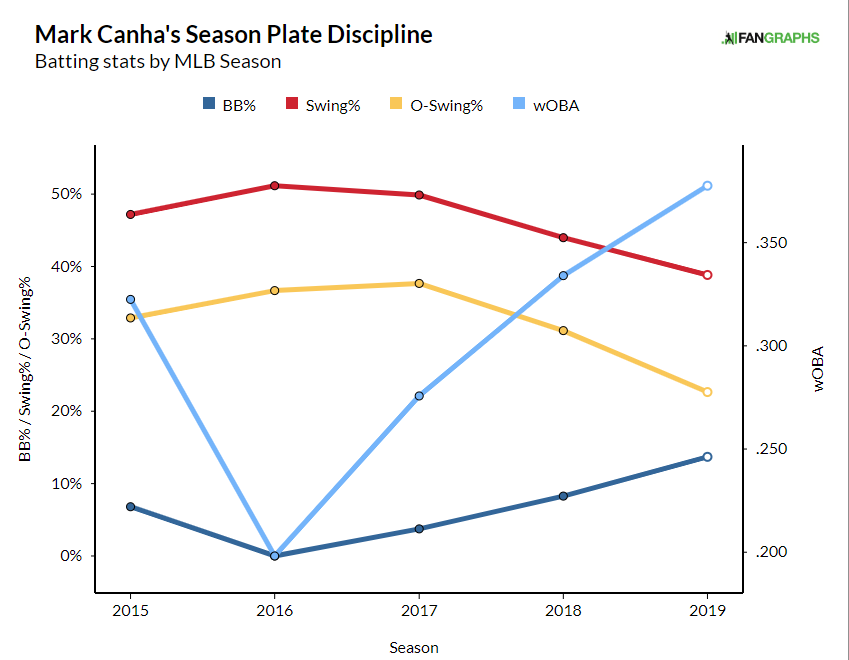The Oakland Athletics are in the middle of the American League Wild Card dogfight with the Cleveland Indians, Tampa Bay Rays and Boston Red Sox. It’s a fight that will probably not ease up anytime soon, as the Indians have played well and restocked at the trade deadline, the Rays have consistently gotten great pitching from their staff en route to allowing the fewest runs in all of baseball and the Red Sox have a lineup that can get hot in an instant are capable of making a run.
The A’s deserve to be where they are, as they feature one of the best run differentials in the American League, backed up by a large plethora of high-quality talent. Khris Davis has seen his production drop off from where it was a year ago, but a lot of production has been made up elsewhere in the form of Marcus Semien breaking out, Ramon Laureano backing up his own breakout from a year ago with an even better offensive season and another strong season from each of their cornerstone players Matt Chapman and Matt Olson.
However, none of those players mentioned are leading the team in wRC+. That honor belongs to Mark Canha, with a 140 wRC+ in 292 plate appearances in 2019, featuring an overall slash line of .254/.380/.521. It’s been a radical transformation that has seen Canha break out this season and change the narrative of his career from one of being a fringe bat to a late bloomer with the potential to get even better. He’s still under 10% owned in both Yahoo and ESPN fantasy leagues. No offense to guys like Wil Myers or Justin Upton, but seriously, how are those two players almost ten times more owned than Mark Canha right now? Canha is definitely getting overlooked but he shouldn’t be for long.
Mark Canha has been logging playing time for the A’s since 2015. He paid his dues in minor league ball long enough to see himself become eligible for the Rule 5 Draft in 2014, where he was selected by the Athletics from the Marlins. In his first crack at the bigs in 2015, Canha produced a solid 105 wRC+ season as a 26-year-old rookie with 16 home runs in only 124 games. 2016 was mostly lost to injuries and 2017 was spent shuffling between the Majors and AAA, and during his limited time with Oakland, he did not impress, putting up just a 70 wRC+ in 57 games. He turned 29 that offseason and it looked like his career was at a crossroads, since most ballplayers don’t get better age and start seeing their skills decline.
But there is a plot twist here. With more playing time in 2018, Canha played his role well and was a pleasant surprise on a surprising Athletics team, as he put up a 113 wRC+, 17 home runs and 2 WAR in 122 games, turning from a sub-replacement level player to a league-average starter. If Canha did most of the same for the A’s in 2019, now a year older at age 30, both Canha and the team would probably be happy about that. Instead, Canha has undergone a series of significant changes that have completely changed his game and turned him into perhaps the strongest hitter in the Athletics lineup. The biggest of these changes have been in his plate discipline. You can really see the differences in this graph here:

Compared to where he was earlier in his career, Canha is swinging less, chasing less and walking more in 2019 than he ever has, which has helped allow his wOBA to jump to the highest point in his career. He’s been waiting for pitches he can do damage with more and not worrying about falling behind in counts. The result has been a complete transformation for him. Here’s how he ranks in some key plate discipline metrics among hitters with a minimum of 250 plate appearances:
| Stat | Rate | Rank |
| BB% | 13.7 | 17 |
| O-Swing% | 22.7 | 16 |
| Swing% | 38.8 | 15 |
| BB/K | 0.68 | 25 |
By these metrics, Canha has been one of the most patient hitters in the game, ranking in the top-25 in these plate discipline metrics. Compare that to last season, and you really see how drastic these changes are:
| 2019 | 2018 | |
| BB% | 13.7 | 8.3 |
| O-Swing% | 22.7 | 31.1 |
| Swing% | 38.8 | 44.0 |
| BB/K | 0.68 | 0.39 |
You really can appreciate the improvements made in plate discipline when you compare his discipline rates from last season to this season. In fact, what Canha is doing this season puts him into a really small group of hitters. I went looking for all the hitters with a minimum of 250 plate appearances that have a walk-rate of at least 13%, a HR/FB rate of at least 20%, an O-Swing rate less than 25% and a BB/K rate of at least 0.60. Here are the results:
| Name | BB% | K% | ISO | wOBA | wRC+ | HR/FB | O-Swing% | Swing% | BB/K |
| Mike Trout | 17.9 | 18.3 | .363 | .440 | 183 | 25.7 | 21.2 | 36.2 | 0.98 |
| Carlos Santana | 16.7 | 15.0 | .245 | .385 | 139 | 20.7 | 20.8 | 38.9 | 1.11 |
| Juan Soto | 15.3 | 20.9 | .238 | .383 | 135 | 20.8 | 23.0 | 40.2 | 0.73 |
| Mark Canha | 13.7 | 20.2 | .267 | .378 | 140 | 21.0 | 22.7 | 38.8 | 0.68 |
| Daniel Vogelbach | 16.3 | 24.3 | .271 | .360 | 130 | 21.7 | 21.9 | 34.3 | 0.67 |
| Tommy Pham | 13.1 | 18.5 | .183 | .356 | 125 | 21.3 | 20.2 | 37.8 | 0.71 |
This looks like a pretty good group of hitters, and it’s surely never a bad thing to be included in a group of hitters that features Mike Trout. This is not only showing some of the most disciplined hitters in the league, but all of these hitters except Tommy Pham are among the best when it comes to isolated power. The top 4 in terms of wOBA are Trout, Carlos Santana, Juan Soto and Canha, who are all among the top-30 in all of baseball by that metric. This is an exclusive group of hitters who have shown an elite blend of power and discipline this season. It may be weird to think that Mark Canha is among them, but he rightly deserves to be there.
Improving his plate discipline skills has helped Mark Canha have more success in 2019, but I think that those improvements have also helped him in another way. Canha had never had much success against right-handed pitching prior to this season. Because of this, he saw a lot of action against lefties last season and was at risk of becoming a platoon hitter. Here’s how he fared against right-handed pitching in his career prior to 2019 compared to 2019:
| PA | AVG | OBP | SLG | wOBA | BB% | K% | |
| Pre-2019 | 705 | .240 | .314 | .417 | .317 | 7.1 | 23.5 |
| 2019 | 206 | .262 | .388 | .536 | .385 | 13.6 | 21.8 |
I’d say that’s quite the turnaround. From 2015 to 2018, Canha’s struggles against right-handed pitching led to him seeing over 37% of his plate appearances come against lefties, one of the highest rates in that span. It was more extreme in 2018, as nearly 40% of Canha’s plate appearances came against left-handed pitching. Only Enrique Hernandez had a higher rate of plate appearances against lefties in as many total plate appearances as Canha did in 2018. This improvement against righties is so extreme that his .924 OPS against right-handed pitching is better than his .847 OPS against left-handed pitching, which is supposed to be the more favorable matchup, but not for Mark Canha.
Canha isn’t without his red flags either, however. One look at his batting profile will show that he is hitting more fly balls this year than he was in 2018. This is usually good, as a more fly-ball heavy approach usually means more home runs. Indeed, Canha has already matched his 2018 home run total of 17 and would be on pace to hit 35 home runs in 600 at-bats, but this increase in fly balls is coming with more infield fly balls. His 23.5% infield fly ball rate is nearly identical to league leader and recently demoted Maikel Franco’s 23.7% rate. Some of that I’m sure has to come from the large amount of foul-territory at the A’s home ballpark, as fellow A’s Jurickson Profar, Matt Chapman and Matt Olson are also among the league leaders in infield fly ball rate, but it should be kept in mind when evaluating Canha going forward.
Additionally, Canha’s 14.8% line-drive rate is second only to Andrelton Simmons‘ 13.5% rate. There is good news with that though in that it has improved tremendously lately. His line-drive rate was the league’s worst at only 5.4% through the end of May, but that also means it has seen a nearly ten-percent increase since then. I don’t think it’s that big of a deal when you look at his Statcast numbers and see a career high in hard-hit rate and improvements in both launch angle and exit velocity compared to 2018, but again, it should be considered when evaluating Canha in the future. There are also playing time concerns. With the return of Stephen Piscotty recently, Canha could see a reduction in playing time, but for whatever it’s worth, Roster Resource still projects him as the everyday centerfielder for now. Things could change when Ramon Laureano eventually returns, but the team should be comfortable bumping Robbie Grossman in favor of Canha, but only time will tell if that’s true. For now, Canha should be in the lineup nearly every day, as he’s been a fixture in the A’s lineup since mid-May.
Mark Canha’s transformation in 2019 has been quite the sight to behold, especially when you consider that he is a 30-year-old player who had been previously valued mostly for his ability to crush left-handed pitching. Late bloomers happen in baseball and I think we can include Canha as one of them. He has completely changed his approach this season and is enjoying an under-appreciated breakout, becoming one of the most patient hitters in the game and developing a unique blend of power and plate discipline that compares well to some of this season’s best hitters and laying a blueprint for sustained success. In the process, he has become one of the best hitters in A’s lineup that is fighting hard for a spot in the postseason.
Featured Image by Justin Paradis (@freshmeatcomm on Twitter)


Do you like Canha or McMahon more ROS?
I would say Canha
Watching him bat, he is a tough out even for the best pitchers. With his position versatility (1B and all OF positions), he might be a mainstay.